Lilac Lanes Cafe
3901 Wooddale Ave.
St. Louis Park
This is the history of two venues located in the building at 3901 Wooddale Ave. in St. Louis Park.
- Lilac Lanes Cafe
- King’s Inn
The building was part of a complex called the Lilac Lanes Shopping Center, which had a prime location at the Northeast corner of Highway 100 and Excelsior Blvd.
The 30,000 square foot shopping center was the first in the State, built in 1941. Unlike Miracle Mile, which was built across Excelsior Blvd. ten years later and is often cited as the earliest of its kind, Lilac Way was not so much a strip mall but a series of buildings anchored by the restaurant and bowling alley, and was much smaller that Miracle Mile’s 154,000 square feet. It was also not all built at one time but grew incrementally, and had standalone buildings.
FRANK THEROS
The Lilac Way Shopping Center was the brainchild of Frank Theros and Nick Phillips. Theros was born in Olibia, Greece, in 1898, and served in the US Army in France in World War I from 1918 to 1919. According to permit approvals published in the Minneapolis papers, he operated the Ha Ha (as in Minnehaha) Cafe at 2629 East Lake Street in 1927 and 1928, and in 1931 he owned the Stadium Café.
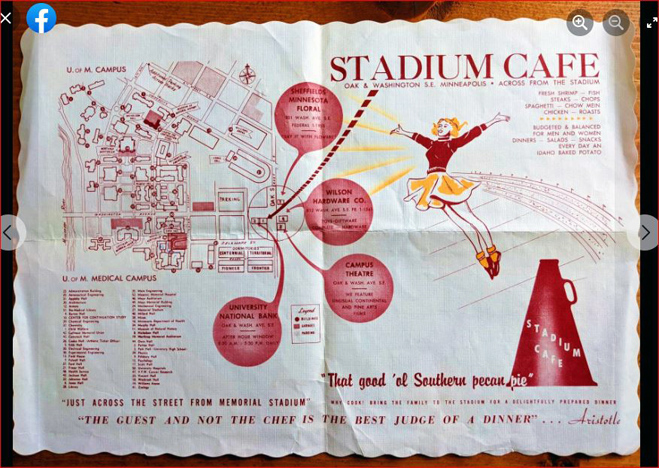
In 1931 the location of the Stadium Cafe was listed as 732 Washington Ave. SE at Oak Street SE, which is in the Stadium Village area of the University of Minnesota. In 1933, Theros is granted one of the first on and off-sale liquor licenses in Minneapolis, dated April 18, 1933, but the address is given as 314 14th Ave. SE, which is across campus in Dinkytown. However, from 1934 to 1937, he is listed again at 732 Washington Ave. SE. This building has been replaced by student apartments.
NICK PHILLIPS
Nicholas Basil Filosofopoulos was born in Tripolis, Greece in 1891. It is unclear whether he served in World War I, as his record only shows a “Military Date” of December 21, 1918. On his military registration card in 1918 he wrote that he worked at a restaurant.
In the 1930s he lived at the Curtis Hotel in Downtown Minneapolis and worked at the cigar stand in the lobby there. On his World War II draft registration card he wrote that he worked at both Lilac Lanes Cafe and the Curtis Hotel. In about 1940 he moved to St. Louis Park.
Phillips died in June 1958, and the Lilac Way Shopping Center went to his wife Elly.
The Lilac Lanes Cafe/Kings Inn stayed in the Theros family. Frank’s son George took it over from Frank.
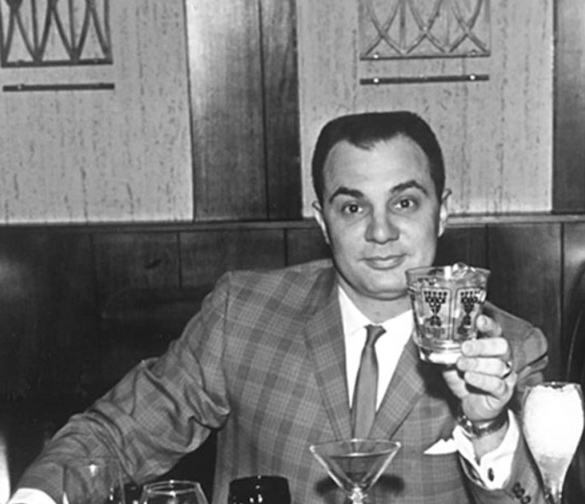
LAYOUT
The complex was built to go around the corner. In the photo below, the road in the lower left corner is Excelsior Blvd., which was known as Highway 212 at the time. The road at the very top is Highway 100. Parallel to Highway 100 is a service road (now Park Center Blvd.) that was called Wooddale Ave. The large white building facing Wooddale/Highway 100 was called the Lilac Lanes Recreation Building in the initial ad announcing the opening date. The rest of the complex was the Lilac Way Shopping Center. Although many of the stores faced the service road, they all had Excelsior Blvd. addresses.
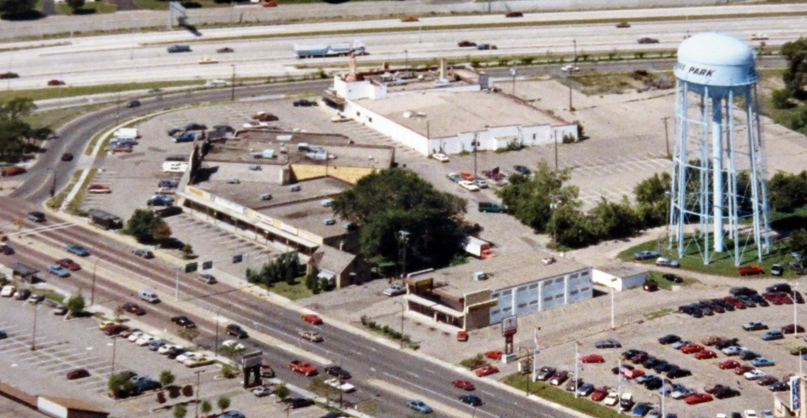
LILAC LANES BOWLING ALLEY
The first business to open at the site was actually the bowling alley, with 20 Brunswick Centennial maple lanes. It opened on December 12, 1941, with St. Louis Park Mayor William Martin “trundling” out the first ball. The new facility featured an automatic electric foul line, locker rooms, fountain, and promised a cafe. Al Borreson was the manager. (Minneapolis Tribune, December 1941)
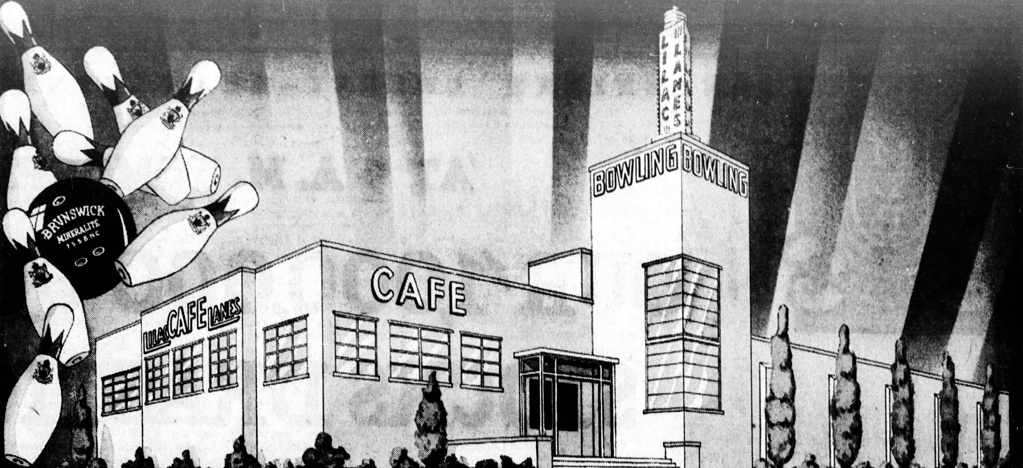
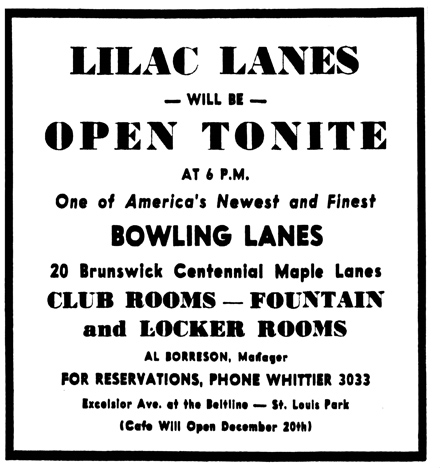
The long section facing Wooddale/Highway 100 was the Cafe. Stretching back behind it, where you see the sign “Ample Parking” in the photo below, was the bowling alley.
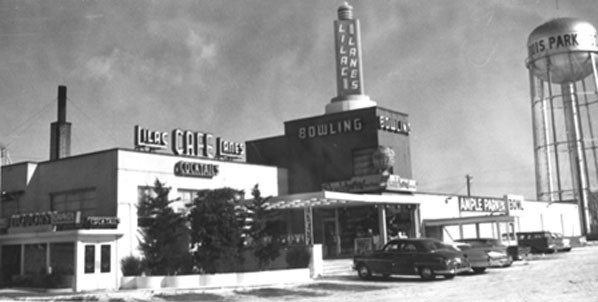
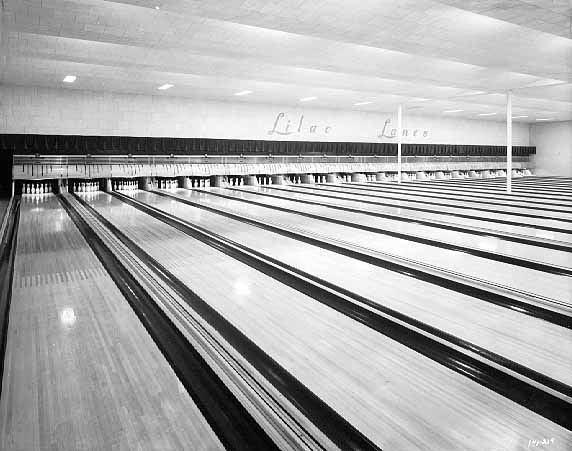
One report (no citation) said that in 1942 the bowling alley was managed by golf pro Jimmy Lentz.
In January 1943, the bowling alley was under new management but must have closed shortly afterwards; a report says that it closed for a year and a half and reopened on September 1, 1944. The reasons were probably War-related.
In 1949 All Borreson was again the Alley Manager. This information must have come from the St. Louis Park Dispatch.
LILAC LANES CAFE
1941
The Cafe came soon after, opening on December 27, 1941. The Cafe was sometimes referred to as Lee’s Lilac Lanes Cafe – it has yet to be discovered who Lee was.
1942
There was another opening on September 5, 1942, under the management of “your genial host Connie Rallis.” The menu included frogs’ legs. (St. Louis Park Dispatch)
1943-1944
As with the bowling alley, reports are conflicting. Near as I can tell, it opened under new management in January 1943 but closed that same month. Reasons for bad business were the war (suburban restaurants needed tires and gas to get to), and the Cafe did not have a liquor license.
1944
The Cafe and the bowling alley reopened on September 1, 1944.
1945
In December 1945, it was announced that two men who had fed thousands of war plant workers during the War, had taken a five year lease on Lee’s Lilac Lanes Cafe. Walter Claasen of St. Paul had been the manager of the cafeteria at Northwest Airlines’ St. Paul bomber modification center. Rudy Engelhart of St. Louis Park had been the cafeteria chef. (Minneapolis Tribune, December 15, 1946; St. Louis Park Dispatch)
1947
The menu in 1947 included:
- Omelette with Chicken Livers and Fresh Mushrooms
- Butter Fried Calf’s Liver, Breakfast Bacon, Bermuda Onion Rings
- Fried Jumbo Green Shrimp
- Grilled Filet Mignon, Bordelaise Sauce
- Broiled Choice T-Bone Stead from our Rotary Grill
Other treats included Navy bean soup, Crabmeat Cocktail, Glazed Parsnips, Prune Whip Pie, and Orange cake with boiled icing. Children got a choice of calf’s liver or chopped sirloin.

1949
Business was bad. Still no liquor license, and the Cafe was reduced to reducing prices and urging families to bring their screaming kids.
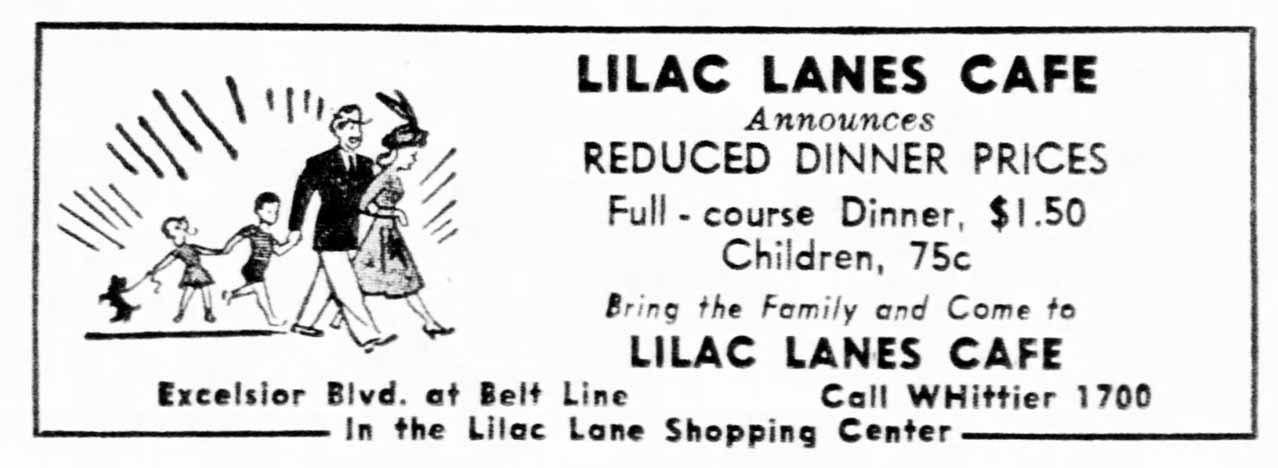
1950
The Federal Census put St. Louis Park over the 10,000 mark at last, and according to State law, that meant that instead of only being able to grant five liquor licenses, it could now issue ten. Although there were plenty of places that could serve 3.2 beer, the ability to serve hard alcohol could make or break a bar or restaurant. In addition, tied to the license was a dance permit. Even in staid 1950, people wanted to dance!
1951
LILAC LANES CAFE GETS A LIQUOR LICENSE
Nick Phillips, who held the license to operate the Cafe, applied for one of the five newly-available liquor licenses. On December 10, 1951, the Village Council granted him a “limited license” for liquor service to patrons seated at tables for food service. They could not drink at a bar, nor could they dance. And of course, they could not drink on Sundays.
Voting against this monstrosity was Councilman Torval Jorvig, who never saw a bar he didn’t want to close. He was joined by Clerk Joseph Justad. The leaders of three nearby churches were also up in arms about this decision, arguing that the Council had used the license to bail the Cafe out of its financial difficulties. In addition, two Councilmen who voted for the permit were due to resign at the end of the year, and the pastors said that the new Councilmen might have voted differently.
Mayor O.B. Erickson pointed out that the area was 100 percent commercial and there were no houses anywhere near the Cafe. “The area to the rear is all industrial and commercial and there probably never will be any residences there.” In addition, Phillips had been a St. Louis Park resident for 20 years, which was taken into consideration. (Minneapolis Tribune, December 12, 1951)
On December 13, 1951, Phillips paid $1,000 of the $2,000 fee for the on-sale liquor license, with the other half due in mid-June 1952. Phillips said it would would take two months at the earliest before he could finish remodeling and start serving liquor at Lilac Lanes. He planned to separate a downstairs ballroom from the bowling alley with a new wall and provide outside entrances for each. He also planned to remodel the front of the building. Food and liquor would be sold at tables in the downstairs ballroom (measuring 88 x 40 feet) and in upstairs dining rooms.
“It means everything to me to run a nice place in an atmosphere of good will. I’m not going to run a joint,” he said. (Minneapolis Tribune, December 14, 1951)
1952
The Lilac Way Cocktail Lounge had its Grand Opening on April 17-19, 1952.
Now, subsequent ads didn’t show this poor waiter with a black eye, I chose it since this was the first one in the series. Although I’d like to think the dessert lady gave him what for when he was too free with his hand…
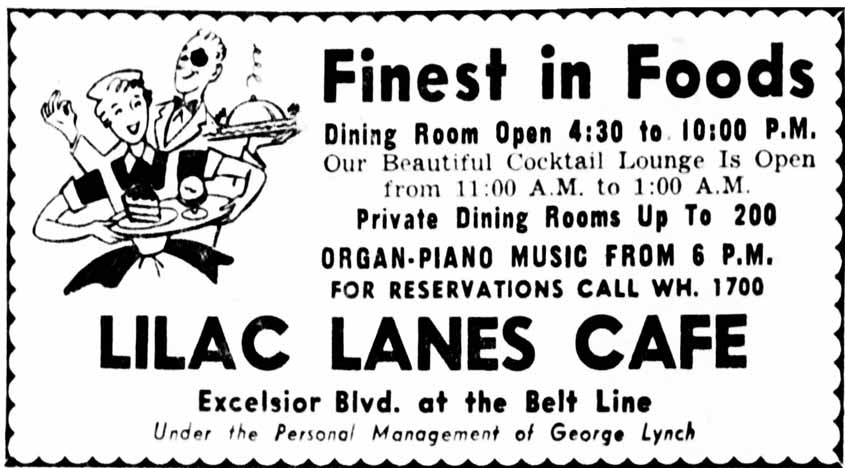
1953
In 1953 Phillips petitioned to have the liquor license transferred to Lilac Lanes Enterprises.
In February the St. Louis Park Village Council turned down Phillips’ request to change his license from restricted to unrestricted. He still could not sell liquor at a bar at the Cafe. (Minneapolis Star, February 3, 1953)
As if to prove that his place was cool, calm, and collected, Frank Theros wrote a letter to the editor describing how 200 graduating seniors came to the Cafe at 5am as a part of their all-night party, “still full of pep.” He insisted it was a wonderful group, and there was “no rowdyism, no damage done, no breakage or taking of souvenirs. Our boys and girls do conduct themselves as ladies and gentlemen.” (Minneapolis Tribune, June 14, 1953)
1954
Restrictions on the Cafe’s liquor license were finally lifted by the St. Louis Park Village Council on January 11, 1954. The Cafe’s lounge had been the only one of six on-sale liquor establishments that were not allowed to sell drinks at a bar.
1955
Dinner music continued into 1955.
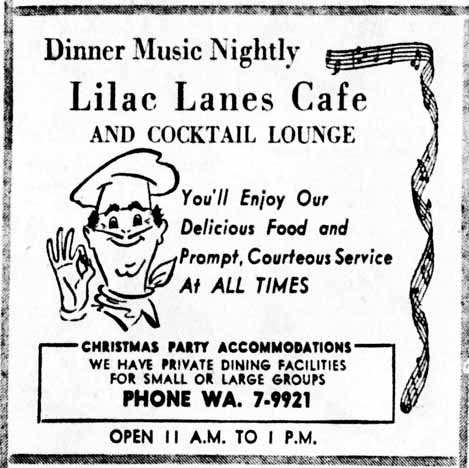
1958
On June 27, 1958, Nick Phillips died at the age of 67.
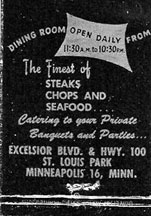
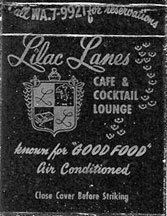
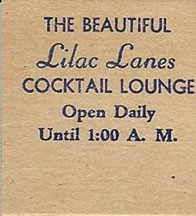
1961
At this point it is difficult to find ads for the Cafe, simply because they chose to write their name in script, which isn’t picked up by the search engine on the newspapers.com database. Obviously sometime between 1955 and 1961, dancing was instituted, as well as the Jolly Note Piano Bar. Plus “smooth melodic music” at dinner.
Some other “Rooms” of note were the:
Esquire Room for men only, and the Stag Room for parties. I can’t imagine what the difference might be. If anyone knows what these men did in these rooms, please let me know.
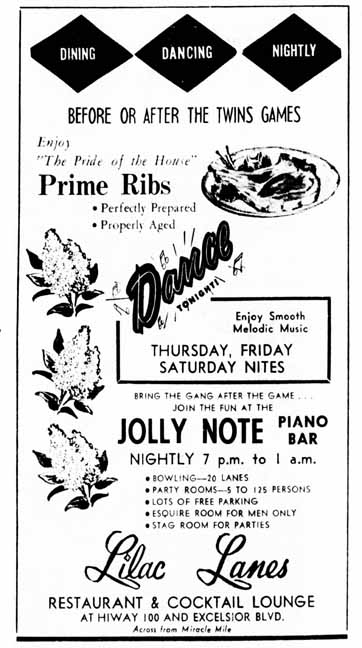
And for a while, there must have been a policy of bringing in semi-big names to entertain the folks. Sophie Parker appeared at other clubs around town.
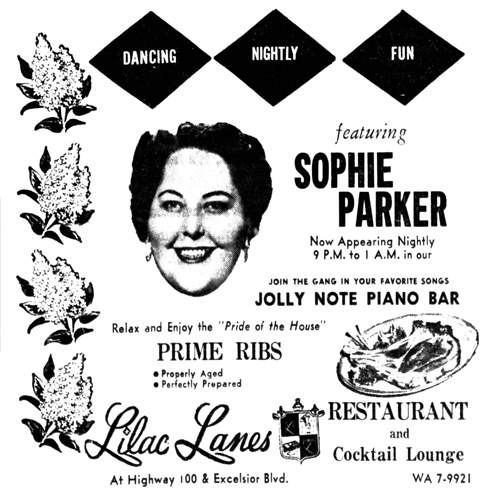
1962
Jimmie Bowman was another local celebrity who entertained at many clubs around town.
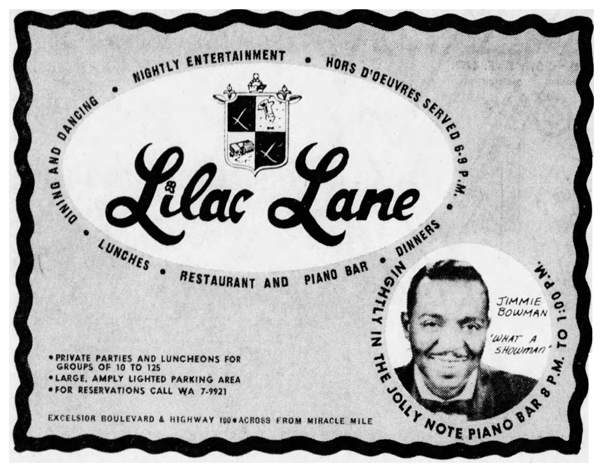
1963
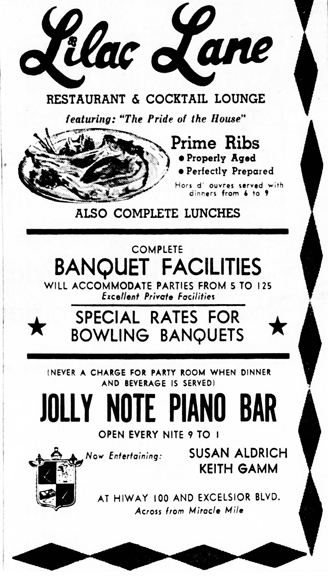
The dining room and bar area were remodeled in the fall of 1963.
1964
FIRE DESTROYS THE CAFE
In the early morning hours of Sunday, January 5, 1964, fire destroyed the Lilac Lanes Cafe and slightly damaged the bowling alley. St. Louis Park police officers were cruising by at 3:30 am and noticed that the front window had blown out of the building and called it in.
George Theros reported that four bars on the first floor, the Cafe (seating capacity 227), and four party rooms (capacity 220) were destroyed, at an estimated loss of $250,000. Other estimates were $100,000 and $200,000.
The bowling alley was covered with soot and had smoke damage, but Theros hoped they would be usable by that evening.
The fire started in the Cafe, possibly from a combination of faulty wiring and a gas leak. (Minneapolis Star, January 6, 1964)
On January 7, 1964, the Star published a photo of one of the cash registers, keys melted from the heat.
THE KING’S INN RISES FROM THE ASHES
After nine months of rebuilding, George Theros completely redesigned the Lilac Lanes Cafe and renamed it the King’s Inn. No longer a Cafe, it was an elegant dining establishment, impressing both entertainment reviewers Don Morrison and Will Jones with its class and opulence.
Morrison called it 1960s Posh, with paneling, fancy light fixtures, rich carpets, and opulent materials on the walls, ceiling, chairs, and tables. The menu was unique – a velvet-textured crimson scroll tied with a gold cord that you unroll to view the bill of fare. The choices were limited, but a favorite was a dish called Eurasian chicken, which was – an entire chicken.
Jones also used the word Posh, and appreciated that the booths were actually comfortable. Some of the booths were actually styled like thrones. He tells us that famous kings “glowered benignly” from mural panels, and that he dined under the nose of Louis XIV. (Minneapolis Star, September 12, 1964); (Minneapolis Tribune, October 18 and 20, 1964)
The King’s Inn became known for many things. One of the most memorable was its salad bar, said to be the first and longest in the area, boasting 76 items. Their motto was “Food Fit for Their Majesties – Our Customers.”
Another was some famous regular customers. TV movie host and pitchman Mel Jass was seen at the King’s Inn – did he really bring his little dog?
1968
Over the years, there were various “Rooms” designated, as mentioned in 1961 with the men’s Esquire Room and the Stag Room. From at least 1968 to at least 1971 there was the Gourmet Room.
In 1968, the Sun Newspapers published an ad with a photo almost identical to the one below, with the tag line, “The Only Twin City Dinner Worth A Tux.”
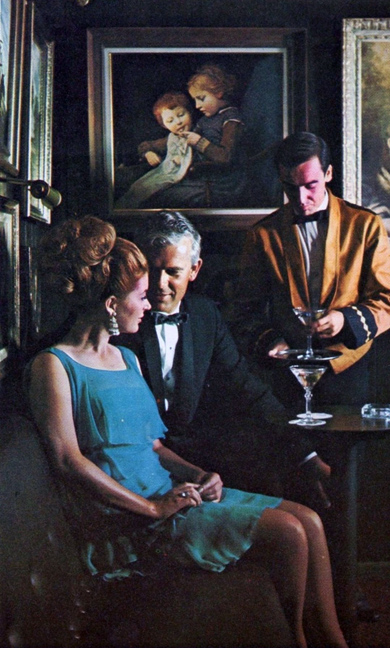
The copy read:
You’ll believe you’re wearing a tuxedo after this elaborate continental dinner served with four full bottles of wine. Cheese Fondue, French Escargots, Coquilles, Goddess Salad, Tenderloin Habachi, and Alaskan Flambe courses handsomely presented with wine . . . . . . . Reservations preferred for this leisurely intimate dinner.
One fellow said there was a dress code and if one didn’t show up with a jacket, one would be supplied. But probably not a tuxedo.
1970
In an article dated December 11, 1970, Don Morrison of the Star reported that he went to check out the new St. Paul branch of the King’s Inn, only to find that it was the old Conroy’s. Although he had nothing but great things to say about it, the St. Paul branch was gone by 1972.
1973
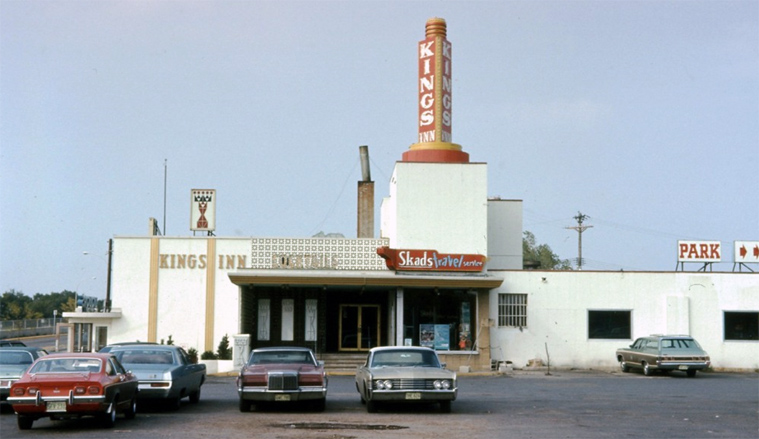
THE END OF THE INN
In the mid 1970s there was increasing talk about designating an Excelsior Blvd. redevelopment district, which threatened the continuing existence of Lilac Way. Despite efforts of many of the merchants to hang on (the King’s Inn did not participate), the old shopping center was ripe for redevelopment. Construction of the 36th St. overpass wreaked havoc on traffic in the area, and the businesses never recovered.
The complex was demolished in September 1988. (Demolition was delayed in the fall of 1987 when soil borings revealed high levels of trichloroethylene.)
The land lay vacant for a long time as many different proposals for redevelopment came and went. Finally, the Park Commons project came into being in the mid 1990s.
CODA
George Theros opened a King’s Inn on Highway 7 and Williston Road after the St. Louis Park location was closed. It became a Famous Dave’s.


